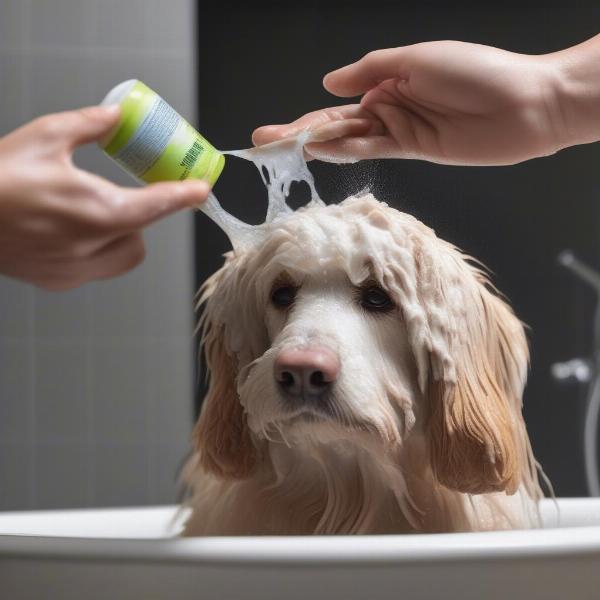Antibacterial shampoo for dogs is a specialized product designed to address bacterial skin infections and other related skin conditions. Choosing the right one and using it correctly is crucial for your dog’s skin health. This guide delves into the world of dog antibacterial shampoos, covering everything from understanding when they are necessary to choosing the right product and using it effectively.
When to Use Dog Antibacterial Shampoo
Antibacterial shampoos aren’t for everyday use. They are specifically formulated for treating bacterial infections, pyoderma, hot spots, and other conditions where bacteria are the culprit. Overusing these shampoos can disrupt your dog’s natural skin flora, leading to dryness and even increased susceptibility to infections. Your veterinarian can diagnose the underlying skin issue and recommend the appropriate course of treatment, which may include antibacterial shampoo.
Choosing the Right Antibacterial Shampoo for Your Dog
The market offers a wide array of antibacterial shampoos, each with different active ingredients and formulations. Some common active ingredients include chlorhexidine, benzoyl peroxide, and ketoconazole.
- Chlorhexidine: This ingredient is a broad-spectrum antiseptic effective against a wide range of bacteria and fungi. It’s generally gentle and well-tolerated.
- Benzoyl Peroxide: Known for its antibacterial and degreasing properties, benzoyl peroxide is effective against acne and folliculitis. It can be drying, so use it as directed.
- Ketoconazole: Primarily an antifungal, ketoconazole is sometimes used in combination with other ingredients to treat infections with both bacterial and fungal components.
Always consult your vet before selecting an antibacterial shampoo. They can recommend a product that’s safe and effective for your dog’s specific skin condition and overall health.
How to Use Dog Antibacterial Shampoo Correctly
Using antibacterial shampoo correctly is vital for effective treatment. Follow these steps for best results:
- Wet your dog’s coat thoroughly with lukewarm water.
- Apply the prescribed amount of shampoo, focusing on the affected areas and lathering gently.
- Allow the shampoo to sit on the skin for the recommended contact time, usually 5-10 minutes. This allows the active ingredients to work.
- Rinse thoroughly with lukewarm water, ensuring no residue remains.
- Dry your dog’s coat completely. A damp coat can create a breeding ground for bacteria.
Potential Side Effects and Precautions
While generally safe when used as directed, some dogs may experience mild side effects like skin dryness or temporary coat discoloration. If you notice excessive redness, itching, or any other unusual reactions, discontinue use and consult your veterinarian immediately. Avoid getting the shampoo in your dog’s eyes or ears.
 Dog Getting a Bath with Antibacterial Shampoo
Dog Getting a Bath with Antibacterial Shampoo
What if My Dog’s Skin Condition Doesn’t Improve?
If your dog’s skin condition doesn’t improve or worsens after using antibacterial shampoo, it’s essential to consult your veterinarian. The underlying cause may be more complex than a simple bacterial infection, or a different type of treatment may be required.
Conclusion
Dog antibacterial shampoo can be a valuable tool in managing various skin conditions. By understanding when and how to use it correctly, and by working closely with your veterinarian, you can help keep your dog’s skin healthy and free from infection. Remember, a vet’s diagnosis is crucial for proper treatment.
FAQ
- Can I use human antibacterial shampoo on my dog? No, human antibacterial shampoos are formulated for human skin and may be too harsh for a dog’s sensitive skin.
- How often should I use antibacterial shampoo on my dog? Follow your veterinarian’s instructions regarding frequency of use.
- What if my dog licks the shampoo? While most antibacterial shampoos are not highly toxic, ingesting large amounts can cause gastrointestinal upset. Prevent your dog from licking the shampoo during and after application.
- Are there natural alternatives to antibacterial shampoo for dogs? Some natural remedies, like oatmeal baths or tea tree oil diluted solutions, may offer some relief for minor skin irritations. However, always consult your vet before using any home remedies, especially for bacterial infections.
- Where can I buy dog antibacterial shampoo? Antibacterial shampoos are available at veterinary clinics and pet supply stores. Your veterinarian can recommend a specific product based on your dog’s needs.
- Can I use antibacterial shampoo preventatively? No, using antibacterial shampoo preventatively is not recommended. It can disrupt the skin’s natural balance and potentially lead to resistance to the active ingredients.
- Is antibacterial shampoo the only treatment for skin infections in dogs? No, your vet might recommend other treatments like oral antibiotics or topical medications in addition to or instead of antibacterial shampoo, depending on the severity and type of infection.
Related Articles
About ILM Dog
ILM Dog (ilmdog.com) is a leading international online resource dedicated to providing dog owners worldwide with practical and reliable information on dog care, health, training, and wellbeing. With a focus on evidence-based practices and expert advice, ILM Dog covers a wide range of topics including breed selection, nutrition, grooming, behavior, and healthcare. We offer comprehensive guides, product reviews, and personalized support to help you navigate every aspect of dog ownership. For inquiries or personalized advice, please contact us at [email protected] or +44 20-3965-8624.